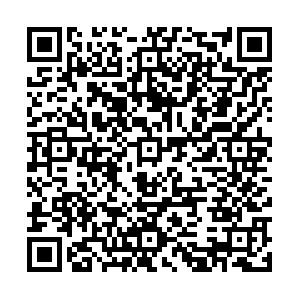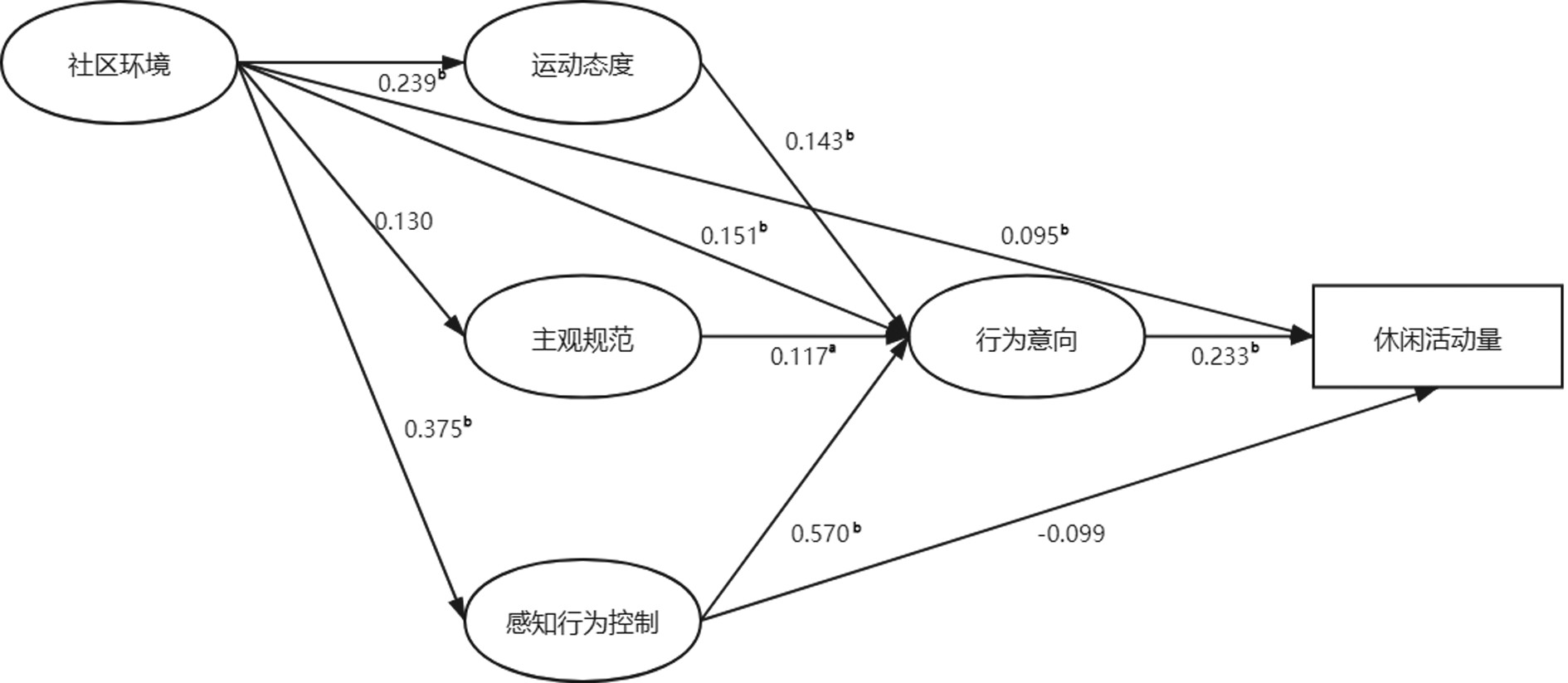The influence of community environment on leisure physical activity among patients with type 2 diabetes
-
摘要:
目的 本研究旨在探究社区环境对于2型糖尿病患者休闲锻炼行为的影响方式。 方法 研究基于计划行为理论, 自行设计2型糖尿病患者调查问卷, 各量表的信效度均良好。通过建立结构方程模型, 研究分析社区环境对于糖尿病患者休闲锻炼行为的直接和间接影响。 结果 本研究对807名2型糖尿病患者的社区环境与休闲锻炼行为进行分析, 发现男性糖尿病患者的休闲锻炼活动量显著高于女性(Hc=4.924, P=0.027)。结构方程结果显示, 运动行为意向对于运动量存在影响(β=0.155, P < 0.001)。同时, 社区环境会通过影响运动态度(β=0.008, P=0.017, 占总效应比重为5.16%)和感知行为控制(β=0.050, P=0.001, 占总效应比重为32.26%)间接影响运动行为意向, 进而最终影响到休闲锻炼行为。 结论 糖尿病患者的休闲锻炼行为活动量有待提高, 社区相关部门应营造良好的运动氛围。同时患者自身应增加对社区运动设施的了解和使用频率, 这对于提高运动量有积极作用。 Abstract:Objective To explore the influence of community environment on leisure physical activity among patients with type 2 diabetes. Methods A self-designed questionnaire based on the the ory of planned behavior for type 2 diabetes was developed. The reliability and validity of exercise situation scale were good. Structural equation model was used to estimate the effects of community environment on leisure physical activities. Results 807 patients with type 2 diabetes were included. Men had significantly higher level of physical activity than women(Hc=4.924, P=0.027). Structural equation model showed that physical activity intention had a significant impact on the amount of physical activity(β=0.155, P < 0.001). Besides, community had influence on physical activity attitude(β=0.008, P=0.017, accounting for 5.16% of the total effect) and perceived behavior control(β=0.050, P=0.001, accounting for 32.26% of the total effect). Finally, community environment had indirect influence on physical activity behavior through physical activity intention. Results Overall, many people don't have sufficient physical activity. Authorities should create a good exercising atmosphere in the community level. Patients are encouraged to use more community sports facilities, which will increase exercise. -
表 1 调查对象人口学特征及休闲活动量比较
Table 1. Characteristics and leisure physical activity among participants
特征 人数 构成比
(%)休闲活动量(千步
当量)/[M(P25, P75)]Hc值a P值 性别 4.924 0.027 女 424 52.5 0.0(0.0, 0.0) 男 383 47.5 0.0(0.0, 24.0) 年龄(岁) 2.650 0.618 ≤50 105 13.0 0.0(0.0, 28.0) 51~ 126 15.6 0.0(0.0, 8.0) 56~ 167 20.7 0.0(0.0, 8.0) 61~ 217 26.9 0.0(0.0, 0.0) ≥66 192 23.8 0.0(0.0, 12.0) 文化程度 7.528 0.057 小学及以下 88 10.9 0.0(0.0, 0.0) 初中 360 44.6 0.0(0.0, 4.7) 高中/中专/技校 214 26.5 0.0(0.0, 8.0) 大专/大学及以上 145 18.0 0.0(0.0, 32.0) 婚姻状况 0.355 0.551 无配偶 49 6.1 0.0(0.0, 0.0) 有配偶 758 93.9 0.0(0.0, 10.7) 家庭人均收入(元) 2.282 0.684 <3 000 239 29.6 0.0(0.0, 0.0) 3 000~ 243 30.1 0.0(0.0, 9.3) 4 000~ 105 13.0 0.0(0.0, 18.7) 5 000~ 169 20.9 0.0(0.0, 16.0) ≥10 000 51 6.3 0.0(0.0, 32.0) 降糖药或胰岛素使用情况 1.096 0.295 不使用 78 9.7 0.0(0.0, 40.0) 使用 729 90.3 0.0(0.0, 8.0) 合计 807 100.0 0.0(0.0, 8.0) 注:a每周千步当量的分组比较采用Kruskal-Wallis检验。 表 2 各群体计划行为理论各维度得分[M(P25, P75)]
Table 2. Scores of the planned behavior theory in different subgroups [M(P25, P75)]
社区环境 运动态度 主观规范 感知行为控制 行为意向 性别 女 6(4, 8) 23(20, 25) 15(13, 18) 16(12, 20) 45(33, 49) 男 6(4, 8) 23(20, 25) 15(15, 20) 17(13, 20) 46(34, 49) Hc值a 0.134 0.002 11.564 0.697 0.033 P值 0.714 0.967 < 0.001 0.404 0.857 年龄(岁) ≤50 6(4, 8) 23(21, 25) 15(15, 19) 16(13, 20) 44(34, 49) 51~ 6(3, 8) 22(19, 25) 15(13, 18) 16(12, 20) 41(28, 49) 56~ 6(3, 8) 24(20, 25) 15(14, 18) 16(12, 20) 48(32, 49) 61~ 6(4, 9) 23(20, 25) 15(13, 20) 18(14, 21) 48(36, 49) ≥66 7(4, 9) 22(20, 25) 15(14, 19) 16(11, 20) 46(34, 49) Hc值a 7.678 7.582 4.664 4.312 8.627 P值 0.104 0.108 0.324 0.365 0.071 文化程度 小学及以下 5(2, 8) 22(20, 25) 15(12, 21) 15(10, 20) 42(25, 49) 初中 6(4, 8) 23(20, 25) 15(13, 19) 16(12, 20) 46(35, 49) 高中/中专/技校 6(4, 9) 23(20, 25) 15(13, 18) 17(14, 20) 46(35, 49) 大专/大学及以上 6(5, 9) 23(20, 25) 15(15, 19) 17(13, 20) 47(34, 49) Hc值a 7.842 3.025 5.808 4.854 3.567 P值 0.049 0.388 0.121 0.183 0.312 婚姻状况 无配偶 5(3, 8) 23(20, 25) 15(13, 18) 18(10, 20) 47(31, 49) 有配偶 6(4, 8) 23(20, 25) 15(14, 19) 16(12, 20) 46(34, 49) Hc值a 0.710 0.042 0.461 0.011 0.202 P值 0.400 0.837 0.497 0.916 0.653 家庭人均月收入(元) < 3 000 6(3, 8) 23(20, 25) 15(13, 20) 16(12, 20) 45(34, 49) 3 000~ 6(4, 8) 23(20, 25) 15(14, 19) 16(11, 20) 46(33, 49) 4 000~ 6(4, 8) 23(20, 25) 15(13, 18) 16(12, 20) 45(31, 49) 5 000~ 6(4, 9) 23(20, 25) 15(15, 19) 18(14, 21) 46(35, 49) ≥10 000 8(6, 9) 23(20, 25) 15(14, 18) 18(13, 21) 48(34, 49) Hc值a 16.568 2.635 5.116 4.340 1.120 P值 0.002 0.621 0.276 0.362 0.891 降糖药或胰岛素使用情况 不使用 6(3, 9) 24(21, 25) 15(14, 19) 16(13, 21) 49(36, 49) 使用 6(4, 8) 23(20, 25) 15(14, 19) 16(12, 20) 45(33, 49) Hc值a 0.079 6.015 0.285 0.031 3.654 P值 0.779 0.014 0.593 0.861 0.056 合计 6(4, 8) 23(20, 25) 15(14, 19) 16(12, 20) 46(34, 49) 注:a表示Kruskal-Wallis检验结果。 表 3 计划行为各维度得分相关系数矩阵
Table 3. Pearson correlation coefficient of the theory of planned behavior
维度 休闲活动量 社区环境 运动态度 主观规范 感知行为控制 行为意向 休闲活动量 1.00 社区环境 0.12a 1.00 运动态度 0.08b 0.15a 1.00 主观规范 0.03 0.12a 0.16a 1.00 感知行为控制 0.10c 0.23a 0.25a 0.18a 1.00 行为意向 0.21a 0.30a 0.30a 0.27a 0.59a 1.00 注:a表示P < 0.001;b表示P < 0.05;c表示P < 0.01。 -
中华医学会糖尿病学分会.中国2型糖尿病防治指南(2017年版)[J].中华糖尿病杂志, 2018, 10(1): 4.DOI: 10. 3760/cma. j. issn. 1674-5809. 2018. 01. 003.Chinese Diabetes Society. Guidelines for the prevention and control of type 2 diabetes in China(2017 Edition)[J]. Chin J Diabetes Mellitus, 2018, 10(1): 4. DOI: 10. 3760/cma. j. issn. 1674-5809. 2018. 01. 003. 张旭熙, 孙凯歌, 吴士艳, 等.北京市通州社区2型糖尿病患者服药依从性和自我管理行为与其血糖控制的相关性研究[J].中国糖尿病杂志, 2016, 24(9): 773-777.DOI: 10. 3969/j. issn. 1006-6187. 2016. 09. 002.Zhang XX, Sun KG, Wu SY, et al. Association between medication adherence combined with self-management behaviors and glycemic control among patients with diabetes in community[J]. Chin J Diabetes, 2016, 24(9): 773-777. DOI: 10. 3969/j. issn. 1006-6187. 2016. 09. 002. Sigal RJ, Kenny GP, Wasserman DH, et al. Physical activity/exercise and type 2 diabetes: A consensus statement from the American Diabetes Association[J]. Diabetes Care, 2006, 29(6): 1433.DOI: 10. 2337/dc06-9910. Knowler WC, Barrett-Connor E, Fowler SE, et al. Reduction in the incidence of type 2 diabetes with lifestyle intervention or metformin[J]. NEJM, 2002, 346(6): 393-403.DOI: 10. 1056/NEJMoa012512. 陈伟, 高民, 江中立, 等. 《中国糖尿病运动治疗指南》解读[J].中华医学信息导报, 2014, 29(2): 19.DOI: 10. 3760/j. issn. 1000-8039. 2014. 02. 012.Chen W, Gao M, Jiang ZL, et al. Interpretation of Chinese guideline for exercise in diabetes[J]. Chin Med News, 2014, 29(2): 19. DOI: 10. 3760/j. issn. 1000-8039. 2014. 02. 012. International Diabetes Federation. Western pacific members: China[EB/OL]. (2019-06-08)[2019-06-08]. https://idf.org/our-network/regions-members/western-pacific/members/101-china.html. Plotnikoff RC, Courneya KS, Trinh L, et al. Aerobic physical activity and resistance training: an application of the theory of planned behavior among adults with type 2 diabetes in a random, national sample of Canadians[J]. Int J Behav Nutr Phys Act, 2008, 5(1): 61.DOI: 10. 1186/1479-5868-5-61. 中华人民共和国卫生部疾病预防控制局.中国成人身体活动指南(节录)[J].营养学报, 2012, 34(2): 105-110. http://www.wanfangdata.com.cn/details/detail.do?_type=perio&id=yingyxb201202001Disease prevention and control bureau of the ministry of health of the people's republic of China. Chinese adult physical activity guide(excerpt)[J]. Acta Nutrimenta Sinica, 2012, 34(2): 105-110. http://www.wanfangdata.com.cn/details/detail.do?_type=perio&id=yingyxb201202001 Barrett JE, Plotnikoff RC, Courneya KS, et al. Physical activity and type 2 diabetes: exploring the role of gender and income[J]. Diabetes Educ, 2007, 33(1): 128.DOI: 10. 1177/0145721706297453. Loprinzi P D, Pariser G. Physical activity intensity and biological markers among adults with diabetes: considerations by age and gender[J]. J Diabetes Complications, 2013, 27(2): 134-140.DOI: 10. 1016/j. jdiacomp. 2012. 09. 004. 朱红亮.糖尿病患者代谢综合征患病状况及影响因素分析[J].中国现代医学杂志, 2017, 27(10): 136-140.DOI: 10. 3969/j. issn. 1005-8982. 2017. 10. 028.Zhu HL. Prevalence of metabolic syndromein patients with diabetes mellitus[J]. China Journal of Modern Medicine, 2017, 27(10): 136-140. DOI: 10. 3969/j. issn. 1005-8982. 2017. 10. 028. Fortier MS, Kowal J, Lemyre L, et al. Intentions and actual physical activity behavior change in a community-based sample of middle-aged women: Contributions from the theory of planned behavior and self-determination theory[J]. Int J Sports Physiol Perform, 2009, 7(1): 46-67.DOI: 10. 1080/1612197X. 2009. 9671892. Heath GW, Parra DC, Sarmiento OL, et al. Evidence-based intervention in physical activity: lessons from around the world[J]. Lancet, 2012, 380(9838): 272-281.DOI: 10. 1016/s0140-6736(12)60816-2. Parrott MW, Tennant LK, Olejnik S, et al. Theory of planned behavior: Implications for an email-based physical activity intervention[J]. Psychology of Sport & amp; Exercise, 2006, 9(4): 511-526.DOI: 10. 1016/j. psychsport. 2007. 07. 002. Rhodes RE, Courneya KS. Threshold assessment of attitude, subjective norm, and perceived behavioral control for predicting exercise intention and behavior[J]. Psychology of Sport & amp; Exercise, 2005, 6(3): 349-361.DOI: 10. 1016/j. psychsport. 2004. 04. 002. Ajzen I. Perceived behavioral control, self-efficacy, locus of control, and the theory of planned behavior[J]. J Appl Soc Psychol, 2002, 32(4): 665-683.DOI: 10. 1111/j. 1559-1816. 2002. tb00236. x. -





 下载:
下载:

